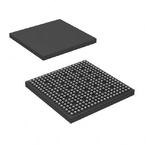● Highlights
● High-Performance Digital Media System-On-Chip (DMSoC)
● Up to 216-MHz ARM926EJ-STM Clock Rate
● Digital HDTV (720p/1080i) output for connection to external encoder
● Video Processing Subsystem
● Hardware IPIPE for Real-Time Image Processing
● Up to 14-bit CCD/CMOS Digital Interface
● Histogram Module
● Resize Image 1/16x to 8x
● Hardware On-Screen Display
● Up to 75-MHz Pixel Clock
● Composite NTSC/PAL video encoder output
● Peripherals include DDR and mDDR SDRAM, 2 MMC/SD/SDIO and SmartMedia Flash Card Interfaces, USB 2.0, 3 UARTs and 3 SPIs
● Enhanced Direct-Memory-Access (EDMA)
● Configurable Power-Saving Modes
● On-Chip ARM ROM Bootloader (RBL) to Boot From NAND Flash, MMC/SD, or UART
● 3.3-V and 1.8-V I/O, 1.3-V Core
● Debug Interface Support
● Up to 104 General-Purpose I/O (GPIO) Pins
● 337-Pin Ball Grid Array at 65 nm Process Technology
● High-Performance Digital Media System-on-Chip
● 135-, 216-MHz ARM926EJ-S™ Clock Rate
● Fully Software-Compatible With ARM™
● Extended Temperature 135- and 216-MHz Devices are Available
● ARM926EJ-S Core
● Support for 32-Bit and 16-Bit (Thumb Mode) Instruction Sets
● DSP Instruction Extensions and Single Cycle MAC
● ARM® Jazelle® Technology
● EmbeddedICE-RT™ Logic for Real-Time Debug
● ARM9 Memory Architecture
● 16K-Byte Instruction Cache
● 8K-Byte Data Cache
● 32K-Byte RAM
● 8K-Byte ROM
● Little Endian
● Video Processing Subsystem
● Front End Provides:
● Hardware IPIPE for Real-Time Image Processing
● Up to 14-bit CCD/CMOS Digital Interface
● 16-/8-bit Generic YcBcR-4:2 Interface (BT.601)
● 10-/8-bit CCIR6565/BT655 Interface
● Up to 75-MHz Pixel Clock
● Histogram Module
● Resize Engine
● Resize Images From 1/16x to 8x
● Separate Horizontal/Vertical Control
● Two Simultaneous Output Paths
● Back End Provides:
● Hardware On-Screen Display (OSD)
● Composite NTSC/PAL video encoder output
● 8-/16-bit YCC and Up to 18-Bit RGB666 Digital Output
● BT.601/BT.656 Digital YCbCr 4:2:2 (8-/16-Bit) Interface
● Digital HDTV (720p/1080i)output for connection to external encoder
● External Memory Interfaces (EMIFs)
● DDR2 and mDDR SDRAM 16-bit wide EMIF With 256 MByte Address Space (1.8-V I/O)
● Asynchronous16-/8-bit Wide EMIF (AEMIF)
● Flash Memory Interfaces
● NAND (8-/16-bit Wide Data)
● OneNAND(16-bit Wide Data)
● Flash Card Interfaces
● Two Multimedia Card (MMC) / Secure Digital (SD/SDIO)
● SmartMedia
● Enhanced Direct-Memory-Access (EDMA) Controller (64 Independent Channels)
● USB Port with Integrated 2.0 High-Speed PHY that Supports
● USB 2.0 Full and High-Speed Device
● USB 2.0 Low, Full, and High-Speed Host
● Three 64-Bit General-Purpose Timers (each configurable as two 32-bit timers)
● One 64-Bit Watch Dog Timer
● Three UARTs (One fast UART with RTS and CTS Flow Control)
● Three Serial Port Interfaces (SPI) each with two Chip-Selects
● One Master/Slave Inter-Integrated Circuit (I2C) Bus®
● Two Audio Serial Port (ASP)
● I2S and TDM I2S
● AC97 Audio Codec Interface
● S/PDIF via Software
● Standard Voice Codec Interface (AIC12)
● SPI Protocol (Master Mode Only)
● Four Pulse Width Modulator (PWM) Outputs
● Four RTO (Real Time Out) Outputs
● Up to 104 General-Purpose I/O (GPIO) Pins (Multiplexed with Other Device Functions)


